Art Term for Amount of Grey in a Color
The History Of Color Theory
General principals of color theory were evident in writings of Leone Battista Alberti (c.1435) and the notebooks of Leonardo da Vinci (c.1490). The first colour wheel was developed by Sir Isaac Newton around the start of the 17th century. This colour bicycle was an system of red, orange, yellow, green, blueish, indigo and violet on a rotating disk.
Since the origination of the color wheel by Newton, information technology has get i of the virtually powerful tools bachelor to artists for explaining the human relationship between colors.
The iii primary colors are reddish, bluish and xanthous. The three secondary colors are greenish, orange and purple. These are fabricated past mixing ii of the primary colors. There are six other tertiary colors.
Using the primary colors, you could mix pretty much any color in the spectrum. This is why a solid knowledge of colour theory is and so important when information technology comes to painting and mixing your colors. This is also why yous should always at a very least accept the primary colors on your palette.

Boutet'due south 7-colour and 12-color color circles from 1708
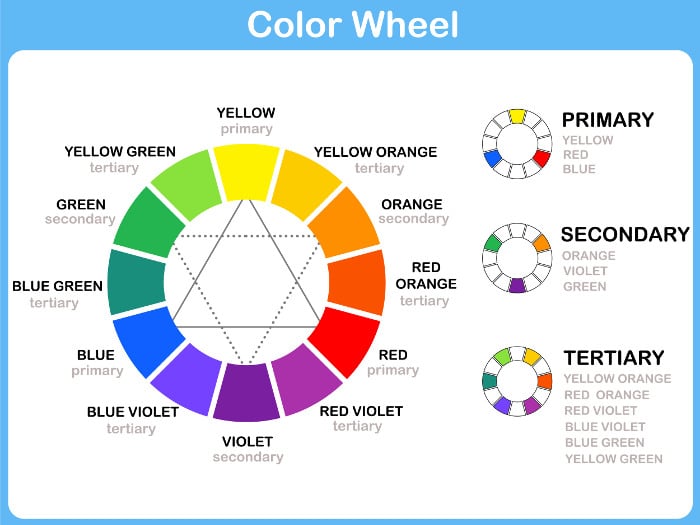
A Modern Mean solar day Colour Bike
Color Theory Terms
There are a number of color theory terms you will come across in art that are unremarkably misunderstood and confused.
Hue
The term "hue" is frequently used equally a simile for the term color. Hue generally refers to the dominant wavelength of color out of the twelve colors on the colour bicycle (existence the chief, secondary and 3rd colors).
For instance, the hue of navy is blueish. The hue of burgundy is red. The hue of sap green is green.
The colors below are hues.

Saturation
Saturation is a measure out of how pure a color is. You tin reduce the saturation of a color by adding gray or a colour on the opposite side of the color bike (which substantially kills the color).
If you completely de-saturate the colour bike, you are left with the following:

Tone
Tone is a widely misunderstood term and many artists are not entirely sure what information technology means, despite it being used so commonly.
Tone is a broad term used to describe a color which is not a pure hue and is non black or white. In many cases, artists employ tone to describe a color which has been grayed down (de-saturated).
Value
Value is how light or dark the color is, on a calibration of blackness to white. Value is widely considered to be one of the most of import variables to the success of a painting.
A general rule I like to follow for painting is:
- To increase (lighten) the value of a color - add white and/or yellow.
- To decrease (darken) the value of a color - add bluish, black and/or raw umber.
Value should be simple to understand, however, the inclusion of color tin make it a challenging concept to grasp. You can have different colors which have the same value. If you take color out of the motion picture, then yous will exist left with merely a range of black to white colors, with blackness existence the everyman and white being the highest value.
This is why cartoon is and so highly regarded for improving painting power, as it makes it easier to grasp the concept of value without having to worry most the inclusion of color.
It is widely considered past artists that value is more important than the color used in a painting. This is because value really sets the structure of your painting.
A value scale is beneath, starting with the highest value (white) to the lowest value (black). Betwixt is basically a grayscale. You can make a colored value calibration by adding white to increase the value and black to decrease the value. When yous take the color away (de-saturate) the calibration should await exactly the aforementioned as the value calibration below. It is that translation betwixt color and value which is extremely hard to acquire in painting.

High Key Versus Low Fundamental
You lot volition often hear paintings described every bit beingness high fundamental or low key. This refers to the overall value scale used in the painting. A high primal painting has a high-value scale (low-cal) whilst a low central painting uses a low-value scale (dark).
High or low key paintings oftentimes accept a very limited value range. Beneath is a depression key painting by Vincent van Gogh (painted before he found color):
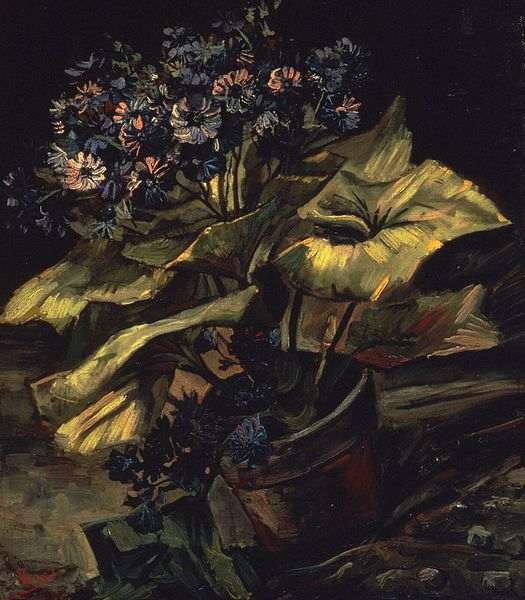
Cineraria, 1886, 54.5 × 46 cm, Vincent van Gogh
Below is a high key painting by Claude Monet.
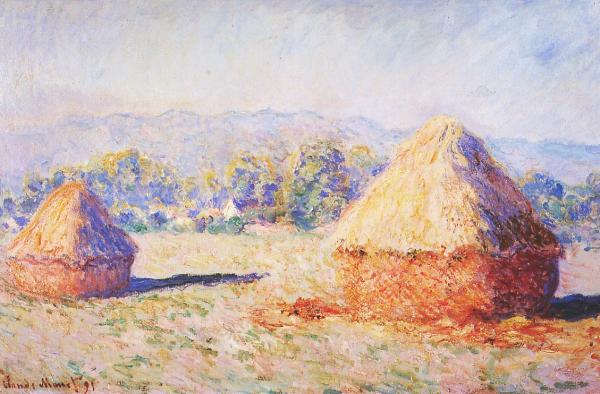
Grainstacks in the Sunlight, Morning Consequence, 1890, Claude Monet
Tints and Shades
Put simply, a tint is a color plus white. A shade is a color plus black. Yous can get a range of tints/shades by calculation varying levels of white/blackness.
TIP: At the moment, these are just words. They take no benefit without awarding. And so I urge you to think of this scenario to put the terms into perspective. Say you lot have a tube of red paint. Nearly beginners would think, great, one color to utilise in my painting. Merely past calculation unlike amounts of white, blackness and gray you have space variations of that color at your disposal. Once I understood this, I really started to come across the options that were available to me.
Color Temperature - Warm Versus Cool Color
The color wheel is divided into warm and cool colors. When a warm color is placed next to a absurd color, there is a very potent contrast. Alternatively, when a cool colour is placed next to another cool color (for example, light-green next to blue) in that location is a pleasing harmonious outcome. These color combinations are discussed in more particular in the section beneath.
Warm colors traditionally indicate action and light. Absurd colors on the other hand indicate at-home, afar and soothing environments.
White, black and gray are by and large considered neutral colors . I get the most use out of these neutral colors not by using them for what they are, but rather to modify the value of my colors. For instance, if you accept cadmium scarlet on your palette, yous can add various amounts of grey to make a range of tones.
At the commencement of a painting, you should determine whether you desire to accomplish a warm, cool or neutral (balanced) feel. When I write neutral, I practice not mean just to use white, black and gray, but rather an equal remainder of warm and cool colors.
Learn more:
Color And Lite - What Is Colour Temperature
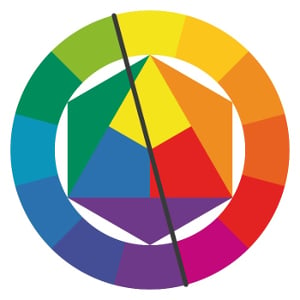
Color Combinations or Schemes
There are a number of commonly known color combinations which can exist used to evoke sure emotions from the viewer.
Before starting a painting, you lot should briefly consider your colour combination to ensure it aligns with your desired statement of the painting. For example, a complementary color scheme could exist used for an aggressive and agile scene. Whilst an analogous colour scheme could be used for a calm and passive surroundings.
Here are some of the most well-known colour combinations:
Complementary
Complementary colors are opposite each other on the color wheel. When placed next to each other, there is an extremely strong contrasting and vibrant event. If overused, your painting may become jarring and uncomfortable to look at.
You should select a ascendant color and utilise the other color equally an accent.
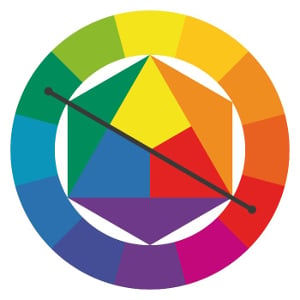
Analogous
A relaxing colour combination using colors positioned next to each other on the color wheel. Coordinating color combinations were famously used by impressionist artists such as Claude Monet to create beautiful harmonious paintings.
It is often almost effective to select one dominant color, a secondary colour and a third accent color.
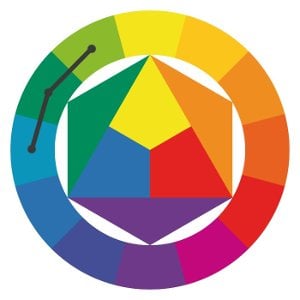
Triadic
A triadic color scheme uses three colors which are evenly placed around the colour wheel. The resulting effect is a vibrant scheme, even with low saturation. Information technology is important to properly residual the colors to not overwhelm the viewer.
Generally, a dominant colour is selected and the other ii colors are used as accents.
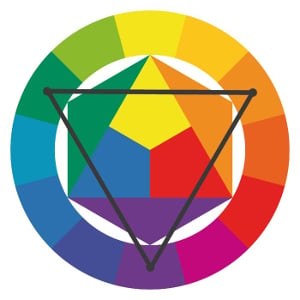
Dissever-Complementary
This is a variation of the complementary color scheme. In addition to the dominant base color, in that location are 2 complementary adjacent colors.
This color scheme is easier to remainder than the complementary color scheme and is a great starting point for beginner artists.
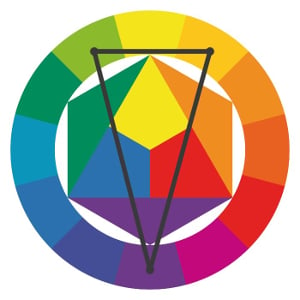
The Psychology Of Color Theory
Color has a powerful influence over human behaviour, to the extent it can manipulate your perception of what is actually there.
Hither are some colors and their emotional influences:
Ruddy: Passion, love, acrimony and danger
Orange: Vitality, creativity and activity
Yellow: Energy, light and hope
Green: Wellness, nature and wealth
Blue: Trust, security and spirituality
Royal: Inventiveness, royalty and wealth
We can use these psychological triggers to influence how nosotros desire the viewer to perceive the painting. If you want the viewer to accept a passionate and ambitious response, so you should be utilizing reds and other warm colors. If you want a calming scene, and then greens and blues should be utilized.
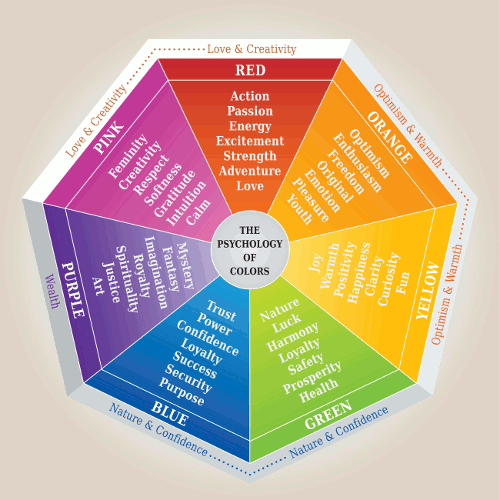
Idealized Views Of Colour
We all take preconceived ideas of what color an object should exist. This idealized view can influence our perception of what is actually in that location.
If you lot are painting trees for example, at that place is a preconceived idea that trees must be light-green. But that is of course not the case. If you are not careful and do not observe the tree for what it actually is, then yous may be fatigued towards adding more green than is necessary based on your idealized view of what the tree is supposed to look like.
It is therefore of import to paint what you run across, non what you call up.
Learning Color Theory As An Artist
Colour theory can be incredibly complex, all the same for artists you only demand to understand the general fundamentals of color theory. The best style to learn color theory is to purchase a color bike or better yet, make your ain using your own paints.
Another technique for learning color theory is to mix your ain value charts of the twelve colors on the wheel (three primaries, 3 secondary and six third). You will end upward with a range of different values of the same color.
For the value chart, outset with your base colour, so work your way up in value past adding white (tints) and down by adding black (shades).
You should end up with a range of charts which yous tin can use for after paintings every bit a reference.
You should besides learn how to paint with a limited palette. The fewer paints you have on your palette, the more yous will be forced to mix your own colors. This will train your mind every bit to how the colors relate to each other.
Summary
I hope y'all establish this post useful. Colour theory is a fascinating surface area and a central noesis for all artists.
This post just touches on the surface of color theory as it is an incredibly complex area. However, I encourage you to learn as much every bit you can almost color theory as it will merely amend your painting ability.
If you have whatsoever questions or comments, experience free to add them in the section beneath.
Take the Quiz
I put together a simple quiz to examination your colour knowledge. Click here to take the color theory quiz.
Boosted Readings
Source: https://drawpaintacademy.com/a-comprehensive-guide-to-color-theory-for-artists/
0 Response to "Art Term for Amount of Grey in a Color"
Postar um comentário